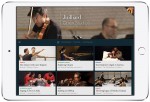Column Name
Title
Juilliard Apps Released
A new app called Juilliard Open Studios takes behind-the-scenes looks at the process of creation and education at Juilliard. In one episode, playwright Tony Kushner coaches fourth-year drama students in how to engage with audiences as they rehearse his seminal Angels in America. In another, choreographer Larry Keigwin creates new work for the fourth-year dancers that's displayed in an interactive feature that allows users to see earlier choreography "ghosted" in the same frame as the new choreography.
Body
The iOS app, which was introduced at the SoHo Apple store in June, uses an ongoing, subscription-based model to "allow us to engage with a much larger world outside our historic base in New York," Juilliard's president, Joseph W. Polisi, said. Episodes are released monthly—the next three, on Staging Il Turco in Italia, Exploring Possibilities in Schubert With Emanuel Ax and Nicolas Namoradze, and Scene Study With Stephen McKinley Henderson, are scheduled to come out on September 3. Juilliard Digital has been creating them over the last year with pioneering app developer Touchpress. The app itself is free to download; users can get one episode for free and the entire library of content can be accessed for a subscription of $7.99 per month.
Another new app that explores the creative and educational processes at Juilliard—and which was also released in June—features the Juilliard String Quartet performing and probing the meaning and historical context of Schubert's "Death and the Maiden" Quartet. Special features of this app include performances of the quartet as well as the Schubert song on which it was based, the ability to highlight individual instruments, and a scrolling score. The Juilliard String Quartet app costs $13.99; both it and the Juilliard Open Studios app are available through the App Store.
Librarians and Musicologists Come to Juilliard
More than 600 distinguished music librarians and musicologists were here in June for a conference on Music Research in the Digital Age that was co-sponsored by the International Association of Music Libraries and the International Musicological Society. Juilliard had never hosted such a large conference before, but due in part to the hard work and key support of staff members throughout the school, it was, by all accounts, a grand success.
This was the first time the two associations had a joint conference with a truly unified program in which librarians and musicologists participated in joint sessions without regard to traditional discipline-specific divides. Potential presentations went through a rigorous winnowing process that resulted in 73 sessions with more than 200 papers. If there was a downside, it was that there were too many concurrent sessions of interest to attend all of them.
A who's who of scholars and librarians made presentations, among them the current and immediate past presidents of the American Musicological Society, whose session was called Collections, Collaborations, Communities. I chaired a session on Digitizing Musical New York, about the performance institution archives of Carnegie Hall, Brooklyn Academy of Music, and the New York Philharmonic. There were also sessions on copyright, music reference sources, web archiving, and digital musicology. One of many highlights was a concert featuring performances of works in our library's special collections; it was introduced by President Joseph W. Polisi. Juilliard performers included pianists J.Y. Song and Conrad Tao; violinist Ray Iwazumi (who also presented a paper at the conference); singers Kara Sainz and Tiffany Townsend with collaborative pianist John Arida; and Melody Nishinaga, Anna Lester, and Sarah Stone from Historical Performance. Juilliard performers also contributed to the conference as ringers in the associations' big band, which performed at the farewell dinner—the culmination of a wonderful week.—Jane Gottlieb, Vice President for Library and Information Resources
The Arts as a Diplomatic Tool
The arts can be a powerful diplomatic tool. A few weeks before school ended in the spring, Juilliard hosted a panel discussion called The Art of Power, The Power of Art. The panelists were President Joseph W. Polisi and Admiral James G. Stavridis, the dean of the Fletcher School of Law and Diplomacy at Tufts University (from which Polisi received a master's in international relations). The moderator was journalist and author Orville Schell, and the audience consisted of Juilliard and Fletcher alumni, friends of the schools, and Juilliard students.
The concepts of soft and hard power comprised the bulk of the discussion—the arts being an example of soft power, a term introduced in the 1980s by Joseph Nye, an American political scientist and international affairs scholar. Stavridis, a retired admiral who served as supreme allied commander of NATO from 2009 to 2013, encourages patience to skeptics who assert that the arts are ephemeral and their effects are short-lived if not nonexistent. "If you look at the trajectory of where we were in the 20th century and the tools we now have," he said, "we're better served by adding that soft power into the mix over the long term." He acknowledged that "you need hard power at times," but "soft power allows you to build bridges. And I have found that the arts are a very compelling kind of soft power."
President Polisi, noting that Juilliard's student body is approximately 30 percent international, talked about the school increasing its role as a global institution. The talk came at a historic moment for Juilliard. With the recent launch of Juilliard String Quartet and Juilliard Open Studios apps (see above), first in China and then in the rest of the world, the school is poised to serve a unique role in building those bridges.—Joshua Simka





